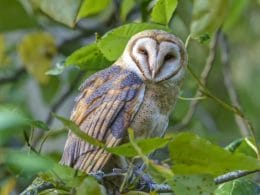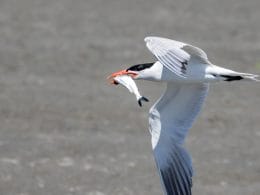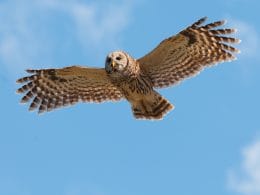North Carolina is known for its humid and subtropical climate, which is ideal for warm-weather wildlife and avian species. In addition, the Tar Heel State has a diverse range of ecosystems due to its varied elevations and landforms.
That’s why North Carolina is one of the best states for birdwatching. It isn’t only home to several woodpecker species. It’s also a great spot for other migratory woodpeckers looking for a warm place to feed and rest before breeding season.
In this article, we provide you with all of the essential information on the nine species of woodpeckers in North Carolina. After you finish reading, you should be able to identify these rambunctious little drummers, so be sure to stick around!
9 Species of Woodpeckers in North Carolina
Six of the nine woodpecker species found in North Carolina are present all year, one spends the winter in the state, one is only found in the eastern region, and one is occasionally seen in Durham.
1. Red-Bellied Woodpecker
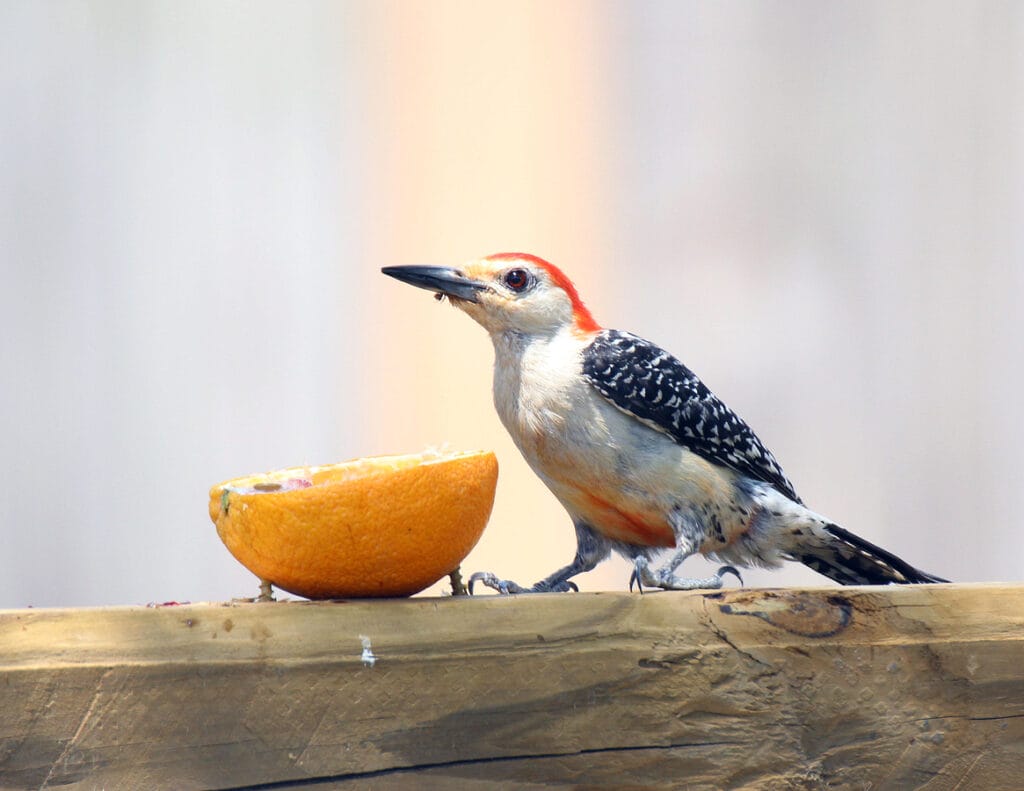
- Scientific name: Melanerpes carolinus
- Length: 9.4 inches
- Weight: 2 to 3.2 ounces
- Wingspan: 13 to 16.5 inches
- Lifespan: 12 years (wild); 12 years (oldest recorded)
It can be confusing at first to identify a Red-bellied Woodpecker from a Red-headed Woodpecker since both species have a characteristically red head.
Remember that, aside from the red blush on the Red-bellied Woodpecker’s belly, its red cap is bright orange-red and only extends from its beak to its nape. Red-headed Woodpeckers, on the other hand, are a deep crimson red from the neck up.
These red-bellied birds are the most common woodpecker species in North Carolina. You can see them throughout the state in both summer and winter. They mainly inhabit woodlands and forests, where they build nests and lay eggs in holes they drill into dead trees.
Red-bellied Woodpeckers are also frequent visitors of bird feeders, especially in backyards near wooded areas. Their main diet mainly consists of insects, but they also eat seeds, nuts, and fruits.
They’re especially fond of suet cakes and sunflower seed, which you can use to attract these redheads to your backyard.
Red-bellied Woodpeckers have barbed tongues that can extend nearly two inches past their beaks. This unique anatomy allows them to use their tongues and sticky spit to catch insects hiding in hard-to-reach places.
2. Red-Headed Woodpecker

- Scientific name: Melanerpes erythrocephalus
- Length: 7.5 to 9.1 inches
- Weight: 2 to 3.2 ounces
- Wingspan: 16.5 inches
- Lifespan: 9.9 years (wild); 9 years (oldest recorded)
Red-headed Woodpeckers, the other redhead on our list, is another permanent resident of North Carolina. They spend the breeding season in western North Carolina but can be found throughout the state the rest of the year.
Even though many woodpecker species have red heads, Red-headed Woodpeckers have a unique plumage that sets them apart from other species. Their entire heads, from the neck up, are a striking deep crimson red, which contrasts with a jet-black and snowy-white body.
Red-headed Woodpeckers can be found around open woodlands, previously burned forests, dead timber in swamps, farms, pine savannas, and other wetland areas. They don’t visit bird feeders often unless it’s winter so that they can eat suet, nuts, and fruits.
That said, these birds are known for their constant habitat shift, so you may not always find them in the same location for two years in a row.
What’s more, Red-headed Woodpeckers are one of the most aggressively territorial woodpeckers, if not the most aggressive. They’ll fight other birds that live in the same territory and even destroy their eggs.
3. Pileated Woodpecker
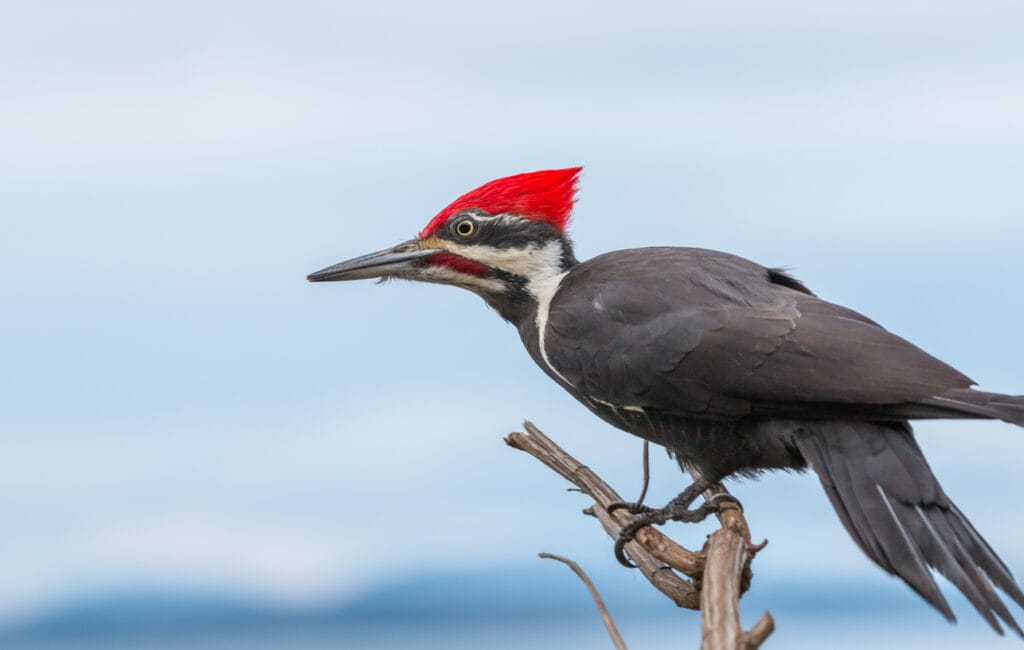
- Scientific name: Dryocopus pileatus
- Length: 15.8 to 19.3 inches
- Weight: 8.8 to 12.3 ounces
- Wingspan: 26 to 29.5 inches
- Lifespan: 12 to 13 years (wild); 13 years (oldest recorded)
If you ever see an enormous black bird with a giant red crest and white stripes extending from the sides of its head to under the wings, you’re looking at a Pileated Woodpecker.
Pileated Woodpeckers are a nonmigratory species that stays all year in North Carolina. They primarily feed on carpenter ants, termites, and beetle larvae, which is why they’re more common in forests with many dead and dying trees.
These giant peckers are efficient excavators, drilling deep triangular holes into trees to extract ants and other insects. Their drumming is often loud enough that it attracts other birds. What’s more, their holes are so deep that they can split trees in half.
It’s sad to say that Pileated Woodpeckers aren’t regular backyard visitors. However, if you live in wooded suburbs, you can try to attract one to your backyard by setting up bird feeders with suet, fruits, and nuts.
4. Downy Woodpecker

- Scientific name: Dryobates pubescens
- Length: 5.5 to 6.7 inches
- Weight: 0.7 to 1 ounce
- Wingspan: 9.8 to 11.8 inches
- Lifespan: 2 to 4 years (wild); 11 years (oldest recorded)
Downy Woodpeckers are the smallest woodpecker species in North Carolina and in North America. These adorable little birds are one of the most common woodpeckers in the state, frequently seen at backyard bird feeders and hummingbird feeders.
You can identify them by their small stature, black back with a large white swath in the center, and black-and-white checkered pattern on their wings. Just keep in mind that they may appear identical to Hairy Woodpeckers at first glance.
Downy Woodpeckers prefer open woodlands with dead trees and decaying tree limbs. These habitats provide them with ideal nesting sites as well as food, such as insects and their larvae.
Still, these small birds can be found in parks and orchards, mixed in with other small birds like chickadees and nuthatches. They mix with other birds to avoid predators and to find food more easily.
5. Hairy Woodpecker

- Scientific name: Dryobates villosus
- Length: 7.1 to 10.2 inches
- Weight: 1.4 to 3.4 ounces
- Wingspan: 13 to 16.1 inches
- Lifespan: 4 to 11 years (wild); 15 years (oldest recorded)
Although Hairy Woodpeckers are visually similar to Downy Woodpeckers, the former is about a third bigger and their beaks are as long as their heads and chisel-like. Their similarities don’t stop here, though!
Hairy Woodpeckers are also year-round residents in North Carolina that prefer large dead trees. They’re common in wooded areas, farmlands, parks, and cemeteries.
However, they prefer burned forests because they attract bark beetles, which are the main food source for Hairy Woodpeckers.
What’s more, Hairy Woodpeckers have the same dietary preferences as Downy Woodpeckers. So, you can attract both woodpecker species to your backyard by setting up a bird feeder with mixed seeds, suet, black sunflower seeds, and peanuts.
Just keep in mind that Hairy Woodpeckers aren’t as common as Downy Woodpeckers at bird feeders.
You may also find Hairy Woodpeckers in the same areas as Pileated Woodpeckers. The much smaller Hairy Woodpeckers search the holes drilled by Pileated Woodpeckers for any insects that may have been left behind.
6. Yellow-Shafted Northern Flicker
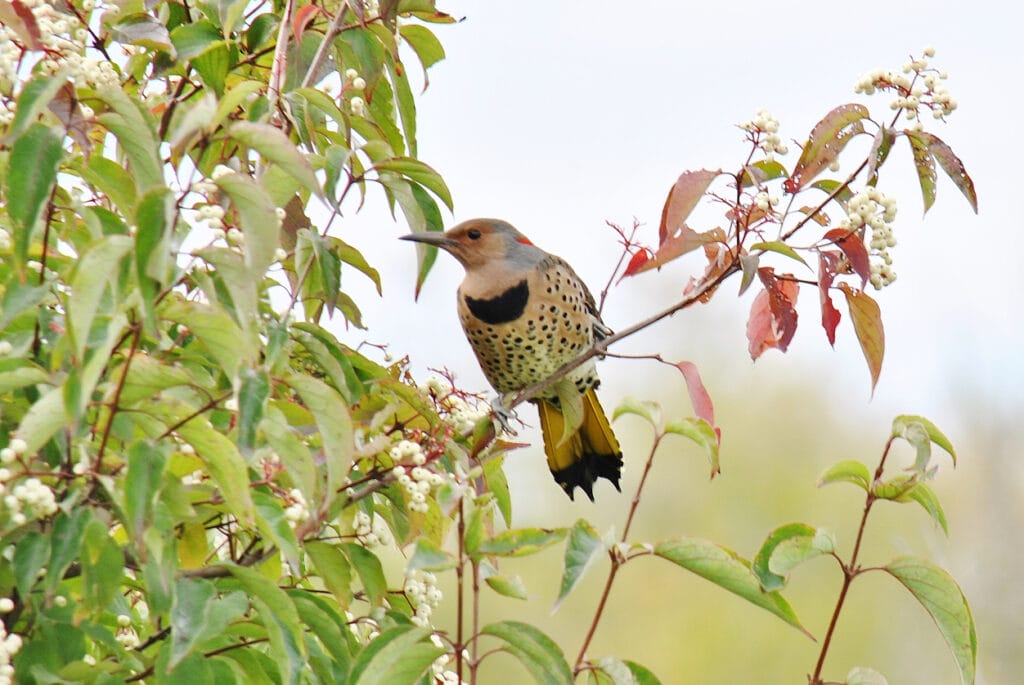
- Scientific name: Colaptes auratus
- Length: 11 to 12.2 inches
- Weight: 3.9 to 5.6 ounces
- Wingspan: 16.5 to 20.1 inches
- Lifespan: 5 to 6 years (wild); 9 years (oldest yellow-shafted Flicker recorded); 8 years (oldest red-shafted Flicker recorded)
The subspecies Yellow-shafted Northern Flicker can be found all year in North Carolina. Their numbers increase in the state during the winter as they return from the south after breeding.
Because these woodpeckers are year-round residents in many areas, some people may be surprised to learn that they’re migratory. Northern Flickers along the North Carolina coast are known to migrate southward more than Flickers in other parts of the state.
In general, some parts of North Carolina have more Yellow-shafted Flickers in the summer and less in the winter, and vice versa.
These birds are at ease in human environments and are frequently seen near bird feeders and birdbaths. Look for a colorful bird with a pale underside adorned with black spots, a red patch on its nape, yellow shafts on its tail, and a black crest on its chest.
However, instead of searching for them in trees, look for them on the ground. Northern Flickers don’t drill trees for food, but rather hammer at the soil with their slightly curved beak. They’ll feed on ants and beetles, but they can also eat snails, flies, and moths.
7. Yellow-Bellied Sapsucker

- Scientific name: Sphyrapicus varius
- Length: 7.1 to 8.7 inches
- Weight: 1.5 to 1.9 ounces
- Wingspan: 13.4 to 15.8 inches
- Lifespan: 4 to 6 years (wild); 7 years (oldest recorded)
The Yellow-bellied Sapsucker is the first woodpecker on our list that’s not a permanent resident in North Carolina. They’re a migratory species that dislikes the winter months, so they migrate to warmer areas after the breeding season.
North Carolina happens to be one of their wintering grounds, so your best chance of spotting one would be in the winter. Luckily, they don’t stick to one area, so you can probably find them anywhere in North Carolina when they’re staying there.
The name of these woodpeckers tells you everything you need to know about them. While Yellow-bellied sapsuckers are predominantly black and white, they have yellow bellies and red patches on top of their heads.
As the second half of the name suggests, sapsuckers drill neat-looking horizontal rows of holes into birch, hickory, or maple trees to drink sap. They insert their bills into the holes and lap up as much sap as they can with their brush-tipped tongues.
8. Red-Cockaded Woodpecker
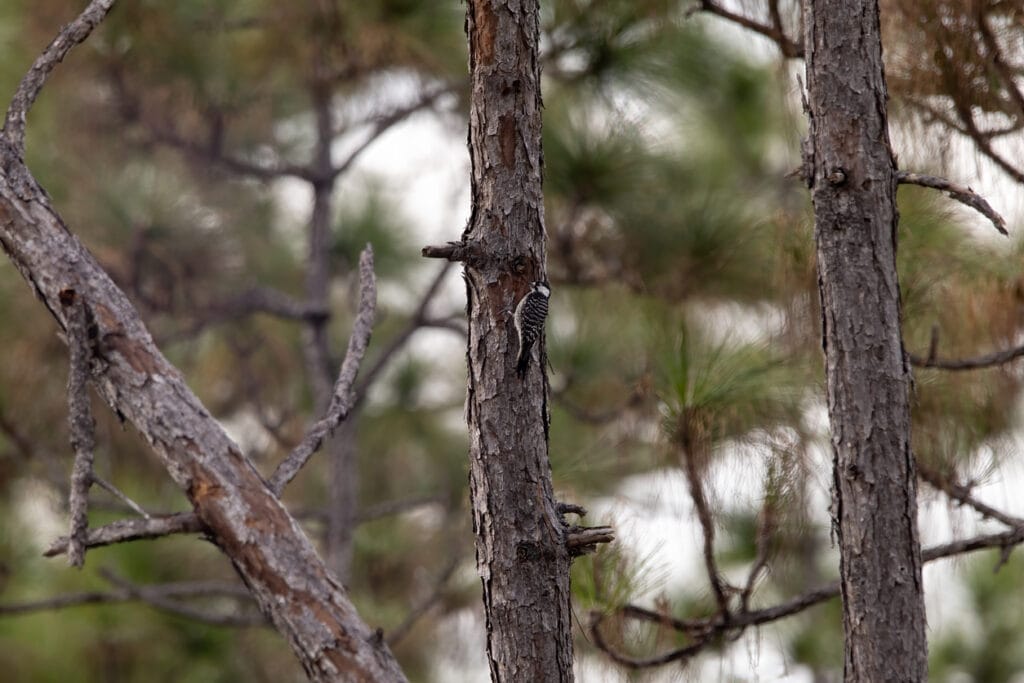
- Scientific name: Dryobates borealis
- Length: 7.9 to 9.1 inches
- Weight: 1.5 to 1.8 ounces
- Wingspan: 14.2 inches
- Lifespan: 16 years (wild); uncertain, but a few banded birds lived over 18 years (oldest recorded)
Even though the name suggests otherwise, Red-cockaded Woodpeckers hardly have any red on their plumage. Only males have a tiny, nearly invisible red streak on their cheeks. Other than that, the woodpeckers have a black and white plumage.
Red-cockaded Woodpeckers are permanent residents of eastern North Carolina in longleaf pine forests. They live inside old pine trees that are softened by red heart fungus. They also feed on the insects and larvae that inhabit pine trees.
Still, due to habitat loss, Red-cockaded Woodpecker numbers have declined to endangered status, which is why they’re rare to come across.
If you live near pine forests, you may be able to attract these woodpeckers to your backyard. You can plant native berry-producing plants, such as elderberries, grapes, bayberries, or hackberries.
9. Acorn Woodpecker
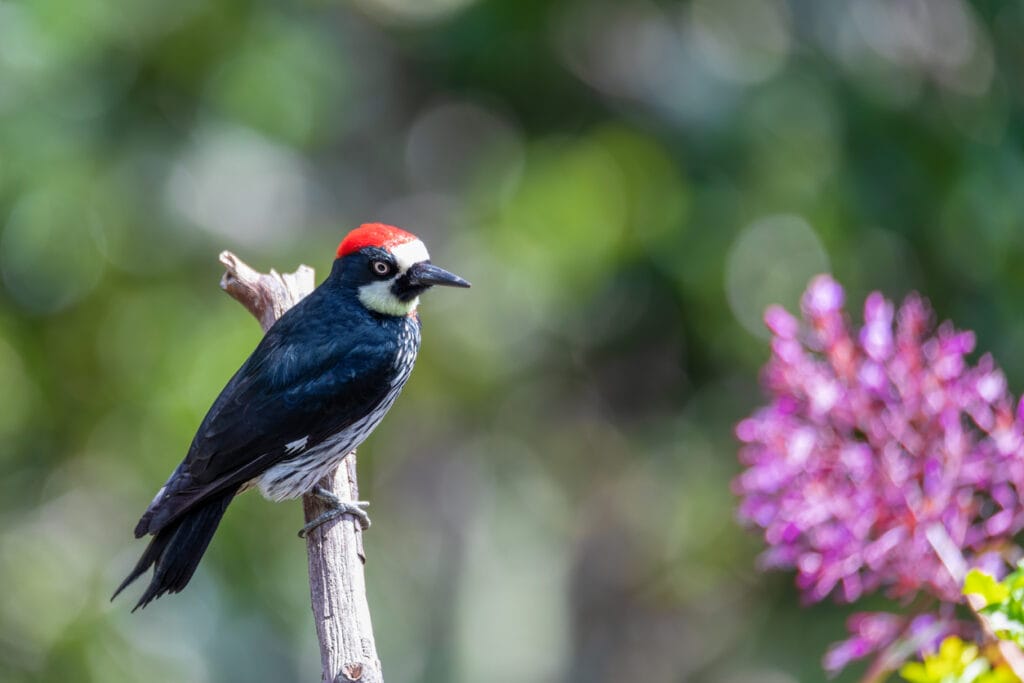
- Scientific name: Melanerpes formicivorus
- Length: 7.5 to 9.1 inches
- Weight: 2.3 to 3.2 ounces
- Wingspan: 13.8 to 16.9 inches
- Lifespan: 9.5 to 16 years (wild); 17 years (oldest recorded)
The last entry on our list is the Acorn Woodpeckers. These birds have wide clownish eyes and a crimson red cap. Their faces are cream-white with a black circle around their beaks. Their chests and back are jet-black, but their undersides are white with lines of black.
Although Acorn Woodpeckers aren’t native to North Carolina, they sometimes can be seen from the Audubon Society branch in Durham.
Unlike many other woodpecker species, Acorn Woodpeckers are incredibly familial. They live in large groups and share breeding spaces. They also store acorns by stuffing hundreds of them into holes they’ve dug in tree trunks.
In Conclusion
North Carolina’s geographical diversity allows it to support both permanent residents and seasonal visitors, including nine woodpecker species.
Most woodpeckers in North Carolina are present year-round, and you don’t have to go beyond your backyard to see these beauties. As soon as you set up a bird feeder with seeds, nuts, and suet, those feathered wood-drummers will be frequent visitors to your backyard.
For some other woodpecker species, you may have to go out of your way to see them, but trust us when we say that these one-of-a-kind woodpeckers are worth the trip!
FAQ
The Red-bellied Woodpecker is not migratory and so can be seen in North Carolina all year round making it just about the most common woodpecker there.
The Alligator River National Wildlife Refuge is a good place to look for the rare Red-cockaded Woodpecker. Airlie Gardens is a good start to look for the Ped-headed and Pileated Woodpeckers. Go to Weymouth Woods-Sandhills Nature Preserve and Croatan National Forest for a chance to see all 3.
To find out where recent sightings of woodpecker have been, try eBird. You can search for the latest sightings or particular species or what has been seen in a certain area.







